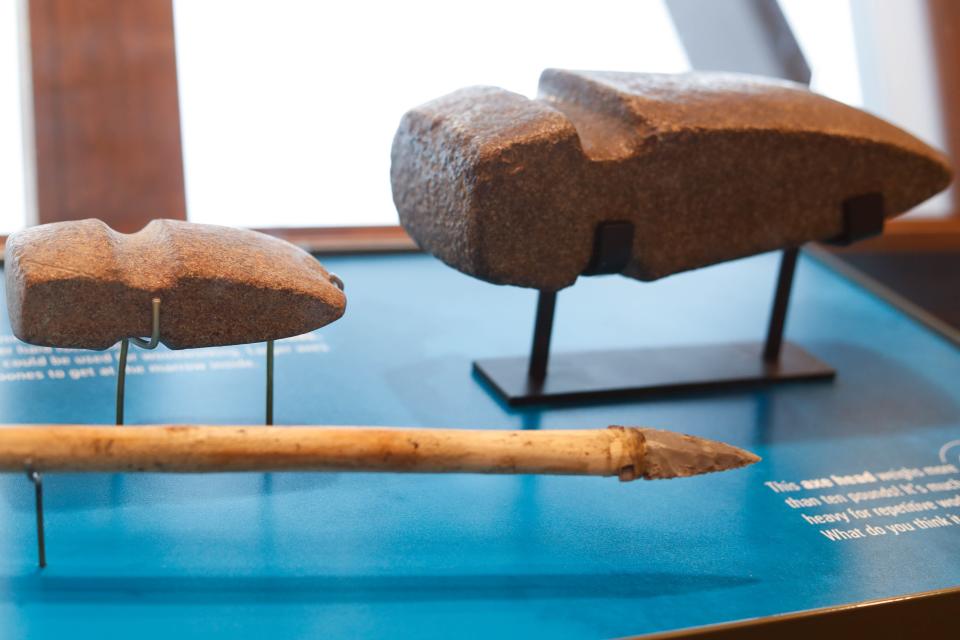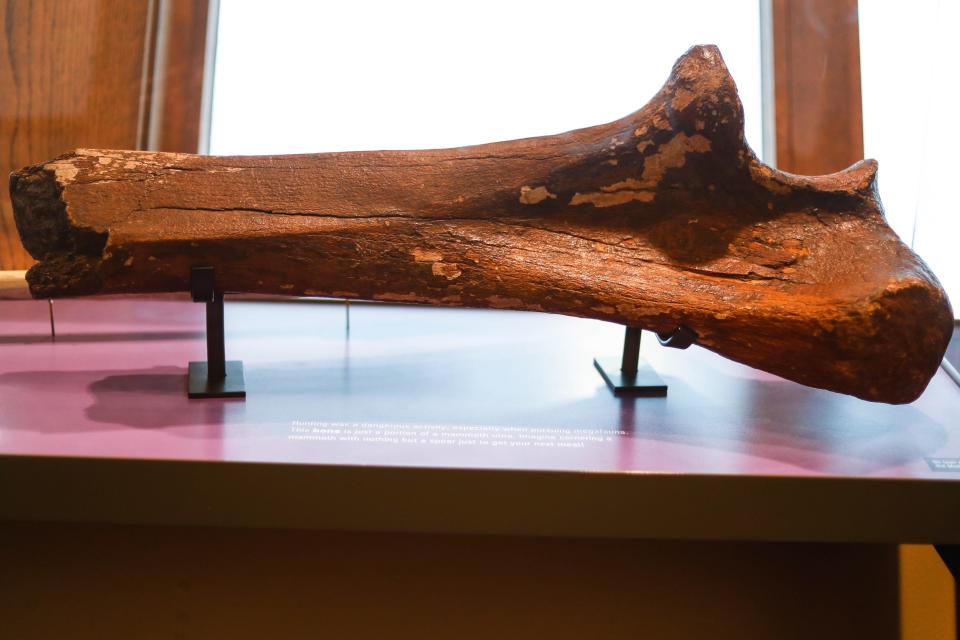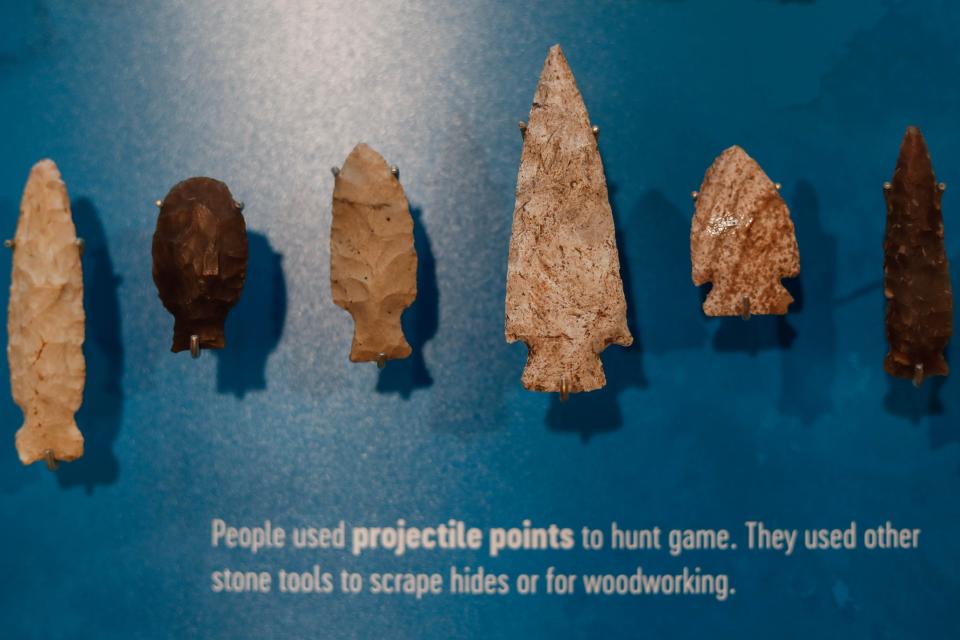New artifact exhibit at Jester Park reveals layers of Polk County's indigenous history
Glen Keeling could have never guessed the story behind a stone his late grandfather used as a doorstop.
The nearly foot-long object is heavy, with a shallow groove on one end, and was among the many artifacts Keeling's grandfather Charles Johnson found on his property, some acres that now make up a portion of Yellow Banks Park in Pleasant Hill. Their family thought that particular stone — a "hatchet-shaped" igneous rock, as Keeling called it — was used by indigenous people who lived and owned the land before them. How and what for, they weren't sure.
"When we were kids, it was always around," Keeling, 76, said of the stone.

Lewis Major, a naturalist at Jester Park Nature Center, owned by Polk County Conservation, said he may have some answers.
Johnson’s stone — which is on display behind a glass case as part of a new artifact exhibit at the nature center in Granger — is an ax head that's somewhere between 3,000 to 7,000 years old and emerged during the Archaic Period. Major said ax heads, tools commonly used to help work with wood or process game, were a game changer for the people in that time period, who began hunting, gathering and harvesting around the area now recognized as Polk County.
But the size of Johnson’s ax head and the faint striations near its tip suggest something else. Maybe, Major and other archaeologists think perhaps the ax head was used to cut down tall trees, bust through ice to get to water or break open bison bone for marrow.
"Some people say all the above," Major said. "Some people say none of the above."
The past leaves clues to understanding the present
Open since early November and in time for National Native American Heritage Month, Jester's latest exhibit shows a glimpse of Polk County's history, dating as far back as 10,000 years ago, when mammoths once roamed the area.
Across five different time periods — Paleoindian, Archaic, Woodland, Late Prehistoric and Historic — visitors will see how the county's first people, including Native Americans, lived as the area changed drastically over the years. Pieces like a 4,000-year-old rock used as a spear point, a fossil bone fragment of a mammoth, or shards of pottery paint a picture of the county's past, Major said.
"See how massive it is?" Major asked of the mammoth bone as he toured the exhibit with the Des Moines Register this week.
In a glass case near the entrance, the weathered ulna bone lies next to a replica of a long wooden spear with a projectile point, which Major said would have been used to kill the mammoth. That bone, he added, was found by a local family in a creek in Madrid, just a short distance from the nature center.

"These were nomadic, big game hunters walking around, and their primary tool was a stick with a stone point on it," Major said of the people living during the Paleoindian Period. "You'd have to get very close to the animals to insert that. You couldn't throw it hard enough to penetrate it. You'd literally have to walk up to it and poke it, and hope you didn't get killed doing it. But that was life."
Major told the Register the exhibit was two years in the making, with the first dedicated to raising funds and the rest to research, design and curation. The center partnered with the University of Iowa Office of the State Archaeologist to document and catalog the pieces, which mostly came from a handful of private collectors such as Johnson, who spent years preserving their findings around Yellow Banks Park, home to a Native American burial ground.
"It's unique in the sense that we can put our finger on that and say 'They all came from right here,'" Major said.
Wayne Phipps, 83, is another collector who donated his roughly 400 pieces to Polk County Conservation.
The Jefferson resident still remembers the first rock he found more than 50 years ago while working on a project in Bondurant.
More:Experience nature in a whole new way: Where to rent snowshoes in central Iowa
In 1970, Phipps was working with engineers and soil conservationists to tile and drain an area that was once a marsh. He recalled a tiling machine unearthing a "strange" dark, dense stone from the ground.
"It had a unique shape to it," said Phipps, adding he later learned the stone may have been used as a projectile point for a spear. The other items in his collection, he said, were found downstream near Yellow Banks Park.
With the exhibit a permanent part of the center, Major said he hopes visitors will take a peek and learn more about their county. Maybe, he said, they'll discover something new.
"That's kind of the fun part of the archaeological history of not just Iowa or our country but who we are," Major said. "Where did we come from? How did we get here? And all these artifacts and tools, what were they really used for?"
Some answers, he said, remain unknown.
"So many of the people that created them are gone — their cultures as well," Major said.

If you go to the Jester Park Nature Center artifact exhibit
The free exhibit is open year-round at the Jester Park Nature Center, 12130 N.W. 128th St., in Granger. The nature center is open 9 a.m. to 4 p.m. Monday through Friday; 10 a.m. to 4 p.m. on Saturdays; and noon to 4 p.m. on Sundays. For more information, visit jesterparknaturecenter.com.
F. Amanda Tugade covers social justice issues for the Des Moines Register. Email her at ftugade@dmreg.com or follow her on Twitter @writefelissa.
This article originally appeared on Des Moines Register: New artifact exhibit in Polk County tells story of indigenous people

